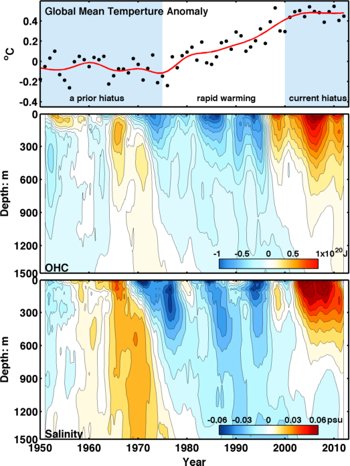 Following rapid warming in the late 20th century, this century has so far seen surprisingly little increase in the average temperature at the Earth’s surface. At first this was a blip, then a trend, then a puzzle for the climate science community.
Following rapid warming in the late 20th century, this century has so far seen surprisingly little increase in the average temperature at the Earth’s surface. At first this was a blip, then a trend, then a puzzle for the climate science community.
More than a dozen theories have now been proposed for the so-called global warming hiatus, ranging from air pollution to volcanoes to sunspots. New research from the University of Washington shows that the heat absent from the surface is plunging deep in the north and south Atlantic Ocean, and is part of a naturally occurring cycle. The study was published on August 22 in Science.
Subsurface ocean warming explains why global average air temperatures have flatlined since 1999, despite greenhouse gases trapping more solar heat at the Earth’s surface.
“Every week there’s a new explanation of the hiatus,” said corresponding author Ka-Kit Tung, a UW professor of applied mathematics and adjunct faculty member in atmospheric sciences. “Many of the earlier papers had necessarily focused on symptoms at the surface of the Earth, where we see many different and related phenomena. We looked at observations in the ocean to try to find the underlying cause.”
The results show that a slow-moving current in the Atlantic, which carries heat between the two poles, sped up earlier this century to draw heat down almost a mile (1,500 meters). Most of the previous studies focused on shorter-term variability or particles that could block incoming sunlight, but they could not explain the massive amount of heat missing for more than a decade.
“The finding is a surprise, since the current theories had pointed to the Pacific Ocean as the culprit for hiding heat,” Tung said. “But the data are quite convincing and they show otherwise.”

Tung and co-author Xianyao Chen of the Ocean University of China, who was a UW visiting professor last year, used recent observations of deep-sea temperatures from Argo floats that sample the water down to 6,500 feet (2,000 meters) depth, as well as older oceanographic measurements and computer reconstructions. Results show an increase in heat sinking around 1999, when the rapid warming of the 20th century stopped.
“There are recurrent cycles that are salinity-driven that can store heat deep in the Atlantic and Southern oceans,” Tung said. “After 30 years of rapid warming in the warm phase, now it’s time for the cool phase.”
Rapid warming in the last two and a half decades of the 20th century, they proposed in an earlier study, was roughly half due to global warming and half to the natural Atlantic Ocean cycle that kept more heat near the surface. When observations show the ocean cycle flipped, in about 2000, the current began to draw heat deeper into the ocean, working to counteract human-driven warming.
The cycle starts when saltier, denser water at the surface northern part of the Atlantic, near Iceland, causes the water to sink. This changes the speed of the huge current in the Atlantic Ocean that circulates heat throughout the planet.
“When it’s heavy water on top of light water, it just plunges very fast and takes heat with it,” Tung said. Recent observations at the surface in the North Atlantic show record-high saltiness, Tung said, while at the same time, deeper water in the North Atlantic shows increasing amounts of heat.


















